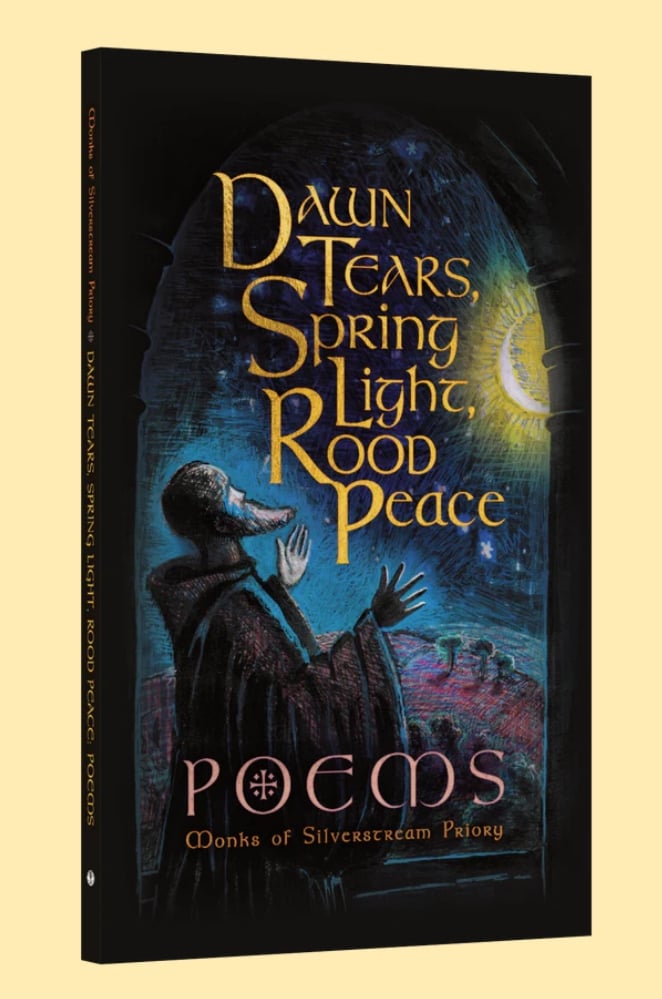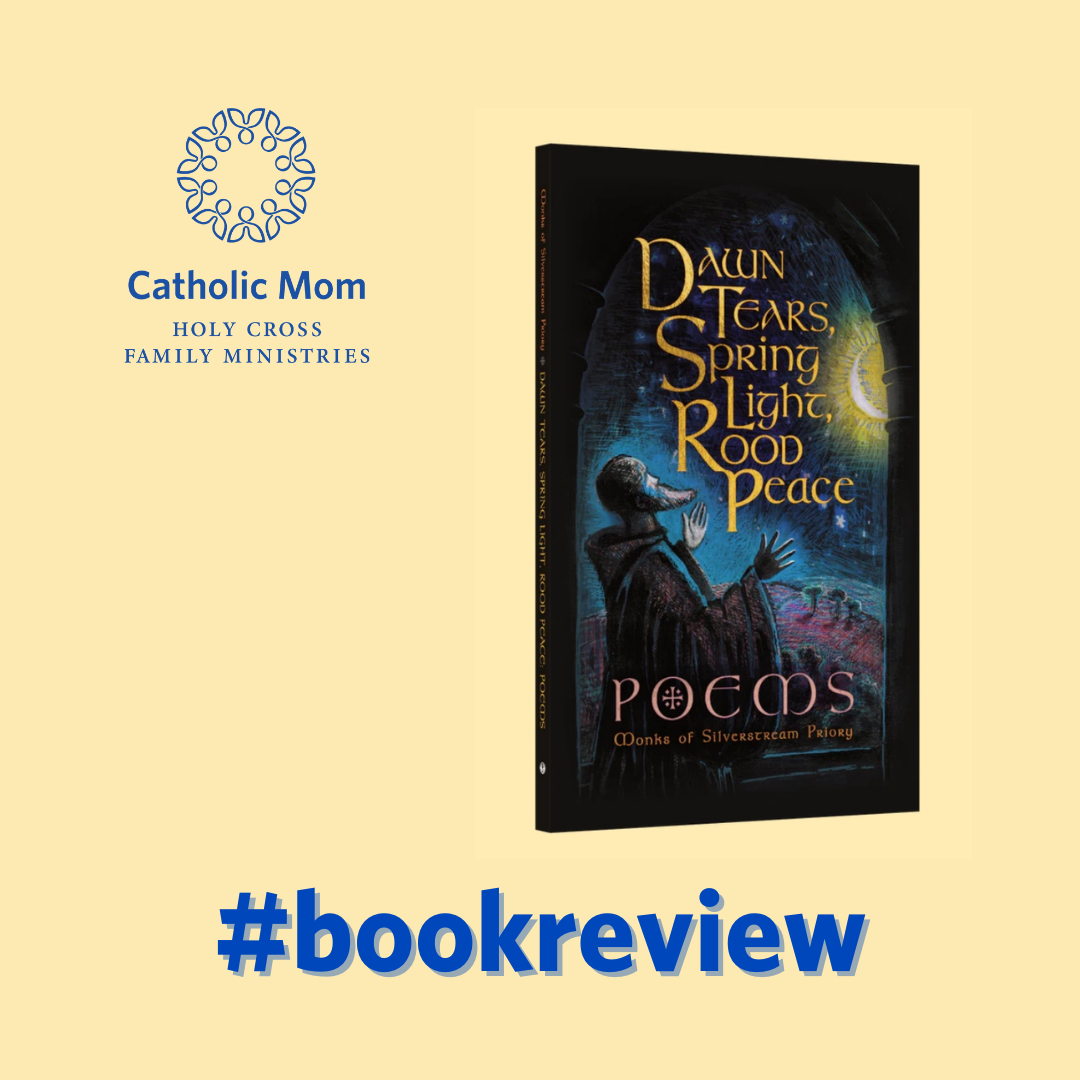
Laurie J. Schmitt reviews a volume of poetry composed by the monks of Silverstream Priory.
Years ago, I crafted a simple, wooden sign expressing St. Benedict’s Ora et Labora. It still hangs above a central doorway within our domestic church. The slogan dominates the busy traffic area of the kitchen and dining room, the places in our home where most of the work and prayer, conversation and celebration happens. Ora et Labora reminds us of God’s grace, and our call to live a life worthy of it.
The sign faces the large crucifix on the opposite wall, making this space a perfect place for our home shrine, praying our morning rosary, lighting vigil candles, and celebrating special occasions and holy days. Our eighteen-passenger dining room table fills the room where, these days, I do most of my writing and illustrating, but not too long ago our homeschooling happened beneath St. Benedict’s Rule. More than once, the students petitioned that the slogan be tweaked a bit, being made to read “Ora et Labora et Laetitia.” These were the days when my eight fun loving sons had our domestic church moving more like a mona-scary than a monastery. (They didn’t need a sign to remind them to have a good time.)
There is a bona-fide, true to the Benedictine rule of life monastery, where prayer, work and joy is obvious and overflowing. The Benedictine monks of Silverstream Priory, County Meath, Ireland, have an Ora et Labora that centers on perpetual adoration of the Blessed Sacrament, and also includes a variety of work projects. Rosaries, candles, and woodworked items are handcrafted by the monks. They create decals, holy cards, and sacred images in their printery, and along with other beautiful books printed there, they also have written their own. Dawn Tears, Spring Light, Rood Peace, a book of poetry by the monks of Silverstream, reads like a spiritual retreat.

The first section, titled "Tears in Dawn," zeroes in on prayer and personal conversion. Take as example, a rendition of the Stabat Mater, wherein fresh words reverberate the same theme, rhythm and rhyme, that of the Blessed Virgin Mary’s suffering at the foot of the cross, bearing witness to her “paining, pining like no other ... she saw her child tender as an unconsoled offender,” and, finally, begging that “lest the blazing fire burn me, O Protectress, do not spurn me when the wheat is put to thresh.” Beautiful. Lyrical. True to form; true to Truth. Stabat Mater, Pange Lingua and the others in this section are poems to meditate on, pondering in your heart the deeper meaning revealed through prayerful introspection.
Joy jumps from this suffering, in the second set of poems found in part two: "Light in the Spring." Happy hearted, this humor is best read aloud, lest the reader be found laughing alone! A few of the poems in this section are patterned after the styles of Gerard Manley Hopkins and G.K. Chesterton, while some of the heroes written of include Pope Gregory VII, St. Dymphna, and St. Thomas Aquinas. Imagine Aquinas, sitting all studious, and smiling at lines like: “Let us sing of St. Thomas Aquinas! of church doctors he's surely the finest, for his score of IQ—if the rumor is true—was the highest of all! (Plus or minus.)” And think of Sts. John Fisher and Thomas More, hearing this epitaph in heaven: they “resisted the feds - who made off with their heads, and soon after to heaven were beckoned.” Happiness leaps from holy hearts!
The tone settles down a bit in part three: "Peace Before the Rood." The poem Sancte Joannes recalls the apostle’s calling from fishing to following Christ: “sitting in the boat—another day. Then, the Voice: ‘Nets aside, and come!’” And Apocalypse 14:13: “‘Come apart,’ the voice rang, and I followed.” The writers of these poems, too, have heard the Voice, and responded, giving the reader cause to wonder: “When have I heard the call? How have I responded?”
This book of poetry, Dawn Tears, Spring Light, Rood Peace, is a happy work of prayer. These poems warm the heart, fire the mind, and melt away stress and distraction. The words center on Christ, the Word, in a way that draws the reader in through his spiritual senses and human experiences. So refreshing to a tired mind! So life-giving to a soul in need of renewal. The Benedictines of Silverstream—word crafters, story makers, and builders of faith—give their creative gifts back to the Creator of all gifts. Dawn Tears, Spring Light, Rood Peace entertains as it lifts hearts, showing the fullness and freedom of a holy and happy life of work and prayer.
Dawn Tears, Spring Light, Rood Peace is a sign for the reader: Work, pray and celebrate God's gracious love for you.

Copyright 2022 Laurie J. Schmitt
Images: Canva
About the Author

Laurie J. Schmitt
Laurie J. Schmitt, a veteran homeschooling mother of nine, is the author of Catholic historical fiction books for children, including Lepanto’s Lady (Our Lady of Victory and the Battle of Lepanto), Champions of the Rosary (Our Lady of Good Help and the Peshtigo Fire) and Giorgio’s Miracle (Eucharistic Miracle of Turin). Picture books coming soon. Follow her at LaurieSchmitt.com and on Instagram @LaurieSchmittbooks.


.png?width=1806&height=731&name=CatholicMom_hcfm_logo1_pos_871c_2728c%20(002).png)
Comments